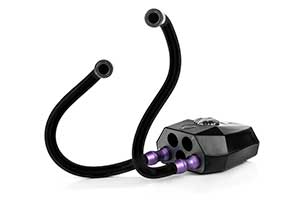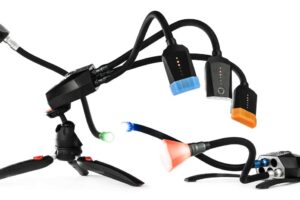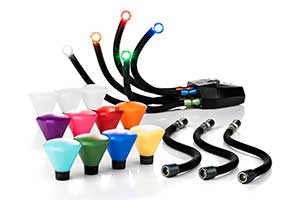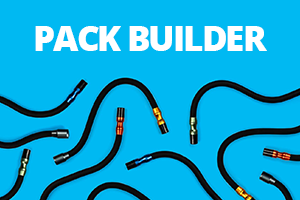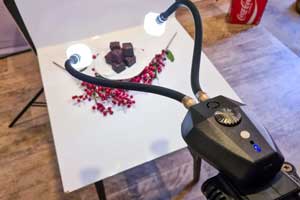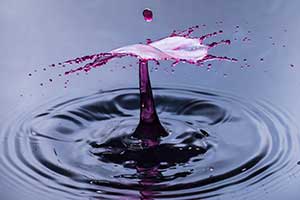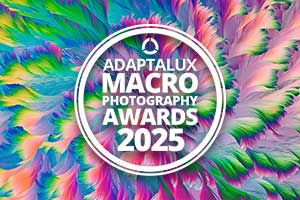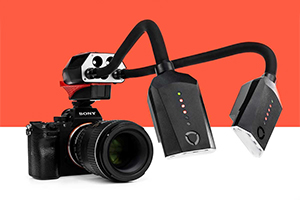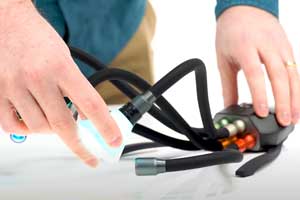UV Caution
UV lighting arms create invisible ultraviolet radiation that can cause harm. Do not look directly into the lighting arm. UV blocking eye protection is recommended at all times while using UV lighting arms.
How to use UV Lighting Arms
UVIVF is a specialist technique that requires a pure UV light source like the Adaptalux Studio UV Lighting Arms. It is a great way to learn about the science of light and explore subjects in a new way.
Caution: UV lighting arms create invisible ultraviolet radiation that can cause harm. Do not look directly into the Lighting Arm. UV blocking eye protection is recommended at all times while using UV lighting arms, such as UV blocking sunglasses for example.
Getting Started
UV Lighting Arms plug into the Control Pod and activate automatically, just like other Lighting Arms. You will not be able to see the light activate, due to UV light being invisible to humans.
To test that your Lighting Arm is on, shine it at something you know to be highly fluorescent. White objects like bed linen, some types of paper, and tonic water make for good test subjects. You should be able to see this fluorescence with your own eyes.
Choosing a UV subject
Most organic materials have some degree of natural fluorescence. It’s sometimes hard to tell with the naked eye, so the best way is to experiment. Healthy flowers and insects are a good place to start. Dead or decaying plants and animals may have significantly less fluorescence or different colours to when they were alive.
For more ideas on subjects, take a look at our blog or YouTube Channel
Choosing a shooting environment
Absolute darkness is important for this kind of photography. Any visible light in your shooting space can easily contaminate your photograph and overwhelm the small amounts of fluorescence created by most subjects.
If your subject is highly fluorescent, like UV pigments or dies, darkness is less important, as the subject will be quite bright.
If you can see anything with your own eyes, your space is likely still too bright. Try shooting in an interior room with no windows. Shooting at night time can also be successful, though even bright moonlight can contaminate images.
Lastly, make sure there are no other fluorescent objects around your subject. White sheets, clothes or paint may create unintended fluorescence that will illuminate your subject with visible light and overwhelm its own fluorescence.
Taking a UVIVF photo
1. Once you have a subject, set up and compose your shot under normal light, in a dark room. Your subject must be still and camera mounted on a steady tripod.
2. Make sure the contacts of the Lighting Arm and Control Pod are clean and insert an arm into your Pod. You will feel a magnetic pull, rotate the arm until it clicks into place.
The arm may need to be rotated slightly to find the lock position. Do not force the Arm to turn once locked.
The UV Arm will illuminate automatically at 50% brightness, increase the brightness up to 100% and position them as close as possible to the subject without obscuring it. The UV Arms are flexible, providing the UV wherever it is needed in the scene. Our Diffusers and Colour Filters are not needed with UV Arms and we advise not to use them.
3. Focus on your subject and switch to manual focus so your camera does not attempt to re-focus later. A White Lighting Arm can be useful when adjusting the camera focus under visible light. Ensure the white Lighting Arm is turned off or removed before proceeding to the next step.
4. IMPORTANT: When you are ready to take your photo, turn out the lights and remove all ambient light from the area, this includes light created by your phone, camera screens or any other equipment present.
5. Shoot a long exposure. Try to keep your ISO low and aperture narrow. Extend your shutter speed as needed until the image is correctly exposed for the dark environment.
6. To remove a UV Lighting Arm and turn off the system, just pull the arm directly outwards from the Pod. Do not twist the Arm, there is no need to twist or “unscrew” the arm.
Additional Resources
Adaptalux Studio information: Adaptalux Lighting Studio
UV Lighting Arm Specifications: UV Lighting Arms



